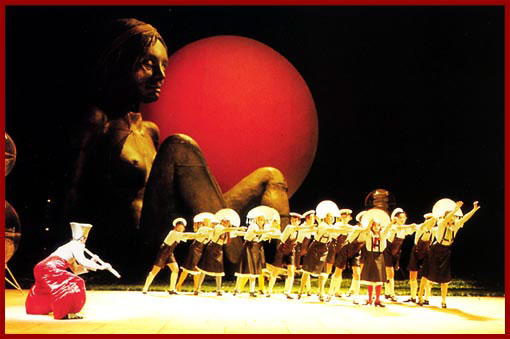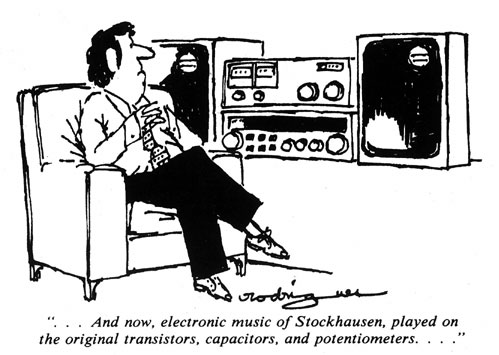
Der Kinderfänger (the Pied Piper), from "Montag aus Licht," Act III, scene 2
Yay! It sounds like he's finished it! Karlheinz Stockhausen has announced that the premier of his life's work, the 29-hour "Licht" ("Light") cycle, will be performed in Dresden in 2008.
I think I've been waiting as long as he has. I've hungrily collected recordings of each of the seven sections, named for the days of the week, as they have gradually become available (I'm only aware of the existence of four at this time), but I've been excited by his music since first hearing it through the CBC/BBC/NDR broadcasts transmitted across the Detroit River in the 1950's. Thank you, Canada.
I actually don't know any of the things about music that could be acquired from formal study; I've had none. But I've been listening to things all my life, most of the time attracted to the less obvious arrangements of sounds. Maybe I'm just a romantic, but I think of Richard Wagner wherever I confront Stockhausen's great project (no, seriously), and I'm not making the association just because of the obvious similarities in the ambitions of these two geniuses.
For a small taste of Stockhausen's storybook, through a short synopsis of the opera's first section, "Montag Aus Licht," see this text from "An Unofficial Website about Stockhausen":
The theatre foyer seems to be underwater, bathed in green rays of light. The inverted Eve formula can be heard from many basset-horns.For more information, see the composer's own site.In the first act a huge statue of Eve is on the sea shore, and is tended to by many woman with perfume and water. (Later this image was adapted for use in a famous television advertisment for the painkiller Nurofen®). The statue, which has three soprano soloists singing down from the larynx, gives birth to seven boys with animal heads who are followed into the world by seven little men from Cologne folk-lore: the Heinzelmånnchen. 3 sailors arrive from the sea to witness an elaborate pram dance with all the nurses and newborns racing geometrically about the beach. All the while surreal events are portrayed through the use of sound samples (e.g. baby animals, steam trains, the Marseillaise sung by a budgerigar), and the children involve themselves in all manner of clamour, mischief and bodily functions. At the height of the chaos an icecream seller arrives on an upside-down bicycle and moments after that Lucifer arrives joined by a web to his grotesque double. He is buried in the sand by the three sopranos. The women's weeping is soon accompanied by falling rain , and the act ends with Lucifer emerging from the sea and ordering the boys back into the womb of the statue.
"Everyone back in!! The whole thing again from the start !!!"
The second act starts with a procession of candle-bearing maidens, and a very long concert grand piano approaches the statue. A short complicated piano piece is played by the boy budgerigar, and the womb of the statue begins to glow. Seven boys of the week are born, and each is taught his own song for his day. The boys are seduced by three female musicians who emerge from the Eve Statue.
In the final act Eve appears playing basset-horn, and performs for her reflection. Soon a musician arrives as an alto-flute player, and joins Eve in a duet. Children come and listen, and eventually the flute player is distracted by them and leads them away into the clouds.
As the public leaves the theatre they find the foyer bathed in clouds, and can hear the children climbing higher and higher, like birds.

[photo image by Henning Lohner from swipnet; cartoon from a 1980 edition of "Stereo Review," via Stockhausen's site today]